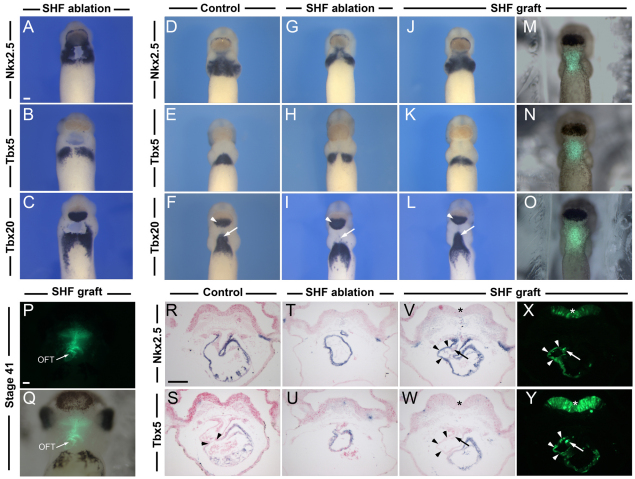Fig. 5.
The SHF contributes to the outflow tract and forms the spiral septum. (A-C) Xenopus embryos at stage 25 immediately after ablation of the SHF and hybridized with Nkx2.5, Tbx5 and Tbx20 probes indicate that the ablated SHF is anterior to the Tbx5 expression domain. (D-F) Expression of Nkx2.5, Tbx5 and Tbx20 in stage 30 control embryos. (G-I) After ablation of the SHF, embryos show an overall reduction in Nkx2.5 expression and a loss of the most anterior cardiac domain of Tbx20 (arrow). Tbx20 is also expressed in the cement gland (arrowhead). Tbx5 expression is largely unaffected. However, SHF-ablated embryos show a delay in the fusion of the PHF at the midline. (J-O) SHF graft restores the anterior domain of Tbx20 expression at stage 30 (arrow, L), and the fusion at the midline of the PHF (K). (M-O) Brightfield views showing the position of the GFP-labeled SHF graft. (P,Q) Fluorescence and brightfield views of a stage 41 embryo after SHF graft at stage 25 showing GFP-positive cells in the developing heart. (A-Q) Ventral views, anterior to top. (R-Y) Transverse sections of similar stage 41 embryos. (R,S) Expression of Nkx2.5 and Tbx5 in stage 41 control embryos. Whereas Nkx2.5 is expressed throughout the myocardium (outflow tract and ventricle), Tbx5 is restricted to the ventricle, establishing a sharp boundary with the outflow tract (arrowheads). (T,U) After SHF ablation, the overall size of the cardiac tissue is extremely reduced but it expresses both Nkx2.5 and Tbx5, suggesting that it is likely to be PHF derived. (V-Y) GFP-labeled SHF-derived cells are detected in the wall of the outflow tract (arrowheads), part of the ventricle and in the spiral septum (arrows). Labeling of the ventricle suggests that the segregation of the PHF and SHF is likely to be incomplete at the time of transplantation (Gessert and Kühl, 2009). In these embryos, the pharyngeal endoderm is also GFP labeled (asterisks) because the transplanted SHF graft contains both mesoderm and endoderm layers (see Table 1). OFT, outflow tract. Scale bars: 100 μm.

